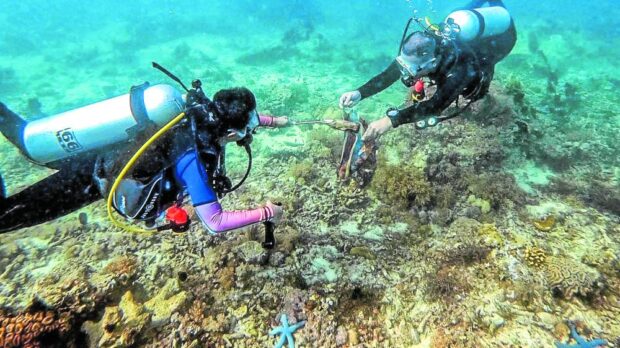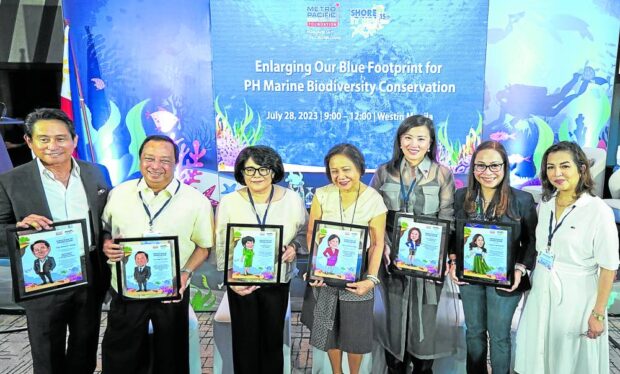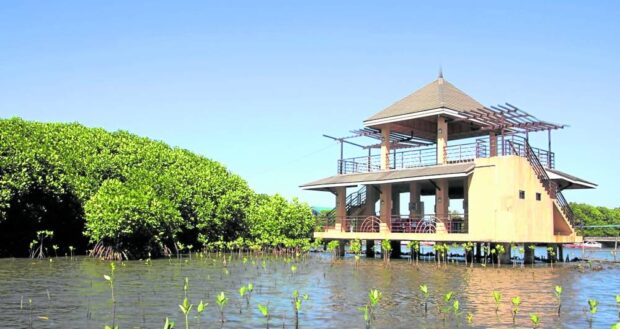Metro Pacific deepens 15-year-old advocacy to clean up the seas

SEA STEWARDSHIP Shore it Up! volunteers collecting underwater rubbish. —Contributed photos
Our unique and rich marine biodiversity is home to a vast number of species whose numbers are greatly diminishing because of a host of factors. In addition, over 3 billion people depend on marine and coastal biodiversity for their livelihoods, not to mention that it also plays a major role in mitigating climate change. Thus, there is a call for collective action to save life below water.
Collaboration between local governments and the private sector has proven to be a winning formula in the conservation of marine life. The exchange of knowledge and resources between the two sectors creates more long-range, impactful and sustainable programs. Among those that have heeded the call to act in the last 15 years is tycoon Manuel V. Pangilinan (MVP)-led Metro Pacific Investments Corp. (MPIC)
The infrastructure conglomerate dives deep into corporate social responsibility through Metro Pacific Investments Foundation (MPIF) with programs that have far-reaching impact of helping promote marine biodiversity, ecological balance and ecotourism.
Its environmental advocacy called Shore It Up! (SIU) was born in the dive resort town of Mabini, Batangas. It began as MPIC’s humble contribution to the annual International Coastal Cleanup and also a response to Metro Manila’s inundation caused by Typhoon “Ondoy” (international name: Ketsana) in 2009.
MPIF used innovative ways to modify the typical cleanup by enlisting volunteer divers to clear the seabed of solid waste and implement community-based educational and livelihood activities to help reduce solid waste at the source.
For more than a decade, these activities served as the template of SIU, which will later develop into a comprehensive and multi-awarded biodiversity program, both here and abroad. This program was replicated in key coastal areas such as Alaminos City in Pangasinan; Del Carmen in Siargao Island, Surigao del Norte; Medina in Misamis Oriental; Cordova in Cebu; and Subic Bay.

BIODIVERSITY FORUM (From left) MPIC head of government relations and public affairs Michael Toledo, Bohol Rep. Edgar Chatto, Environment Secretary Maria Antonia Yulo-Loyzaga, Sen. Cynthia Villar, Tourism Undersecretary Shereen Gail Yu-Pamintuan, Metro Pacific chief finance, risk and sustainability officer Chaye Cabal-Revilla and MPIF president Melody del Rosario
“Our archipelago is teeming with world-renowned hubs of biodiversity and requires a strong support system from the private sector when it comes to preservation and conservation. We at the Foundation want to ensure that we play our part in future-proofing what we have and help mitigate climate change,” says Melody del Rosario, president of MPIF.
Fifteen years later, SIU has expanded its footprint to 12 locations, mobilizing some 87,000 volunteers, 2,600 runners and 1,034 scuba divers. It has since then reached out to 464 organizations and local governments, 180 families and 2,800 schoolchildren or the Junior Environmental Scouts.
It has also trained and provided support to 10 eco-guides and 36 marine guardians to protect the coastal and aquatic resources, helping boost ecotourism in the process.
A prominent program component is the Mangrove Propagation and Information Center, which was put up in Alaminos, Siargao and Cordova, Cebu. These multipurpose pavilions serve as a reception area for tourists before heading out to the Hundred Islands in Alaminos, the Mangrove Forest and Sugba Lagoon in Siargao, or viewing the panoramic Cebu-Cordova Link Expressway across the Mactan Channel.
‘Gabay Kalikasan’
In addition, SIU also helps protect and preserve two sites that are classified as “Ramsar Wetlands of International Importance” under the Ramsar Convention. One is Tubbataha Reefs Natural Park in Cagayancillo, Palawan. This is the country’s largest marine protected area and is a Unesco World Heritage Site. The other is Las Piñas-Parañaque Wetland Park in Manila Bay. SIU is currently helping Del Carmen town, home to 4,871 hectares of contiguous mangrove forest, to attain membership in the prestigious Ramsar Convention.
With its vast coverage, SIU has emerged as the flagship program of the MPIF, which is part of Gabay Kalikasan, one of the business group’s advocacies for a sustainable Philippines.
A multisectoral forum titled “Enlarging our blue footprint for Philippine marine biodiversity conservation,” which gathered top government policymakers on the environment, was recently held in celebration of SIU’s 15th anniversary.

ECO-OUTPOST The Mangrove Propagation and Information Center in Alaminos City, Pangasinan
The highlight of the event was the in-depth discussion on collaborative efforts in safeguarding Tubbataha Reefs Natural Park, facilitated by Angelique Songco, superintendent of the park area.
Situated in the Sulu Sea off mainland Palawan, Tubbataha is a 96,828-hectare award-winning biodiversity-rich marine protected area. It is a recipient of financial and logistical support from the MPIF for the physical upkeep of the ranger station, as well as regular marine patrols to prevent illegal entries into the world-renowned marine park.
The forum was also attended by Sen. Cynthia Villar, chair of the Senate committee on environment and natural resources, Bohol Rep. Edgar Chatto, chair of the House standing committee on climate change, Department of Environment and Natural Resources Secretary Maria Antonia Yulo-Loyzaga and Department of Tourism Undersecretary Shereen Gail Yu-Pamintuan.
Metro Pacific chief finance, risk and sustainability officer Chaye Cabal-Revilla represented the private sector. She also outlined the MVP Group’s sustainability practices through the Gabay Kalikasan program, which is aligned with the United Nations Sustainable Development Goals.
MPIF also signed a memorandum of agreement with the University of the Philippines (UP) and the UP Marine Science Institute to jointly address marine environmental concerns and promote good governance for effective management of the country’s natural resources and marine ecosystems.
